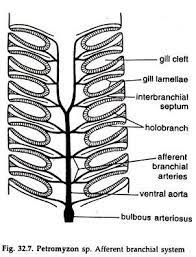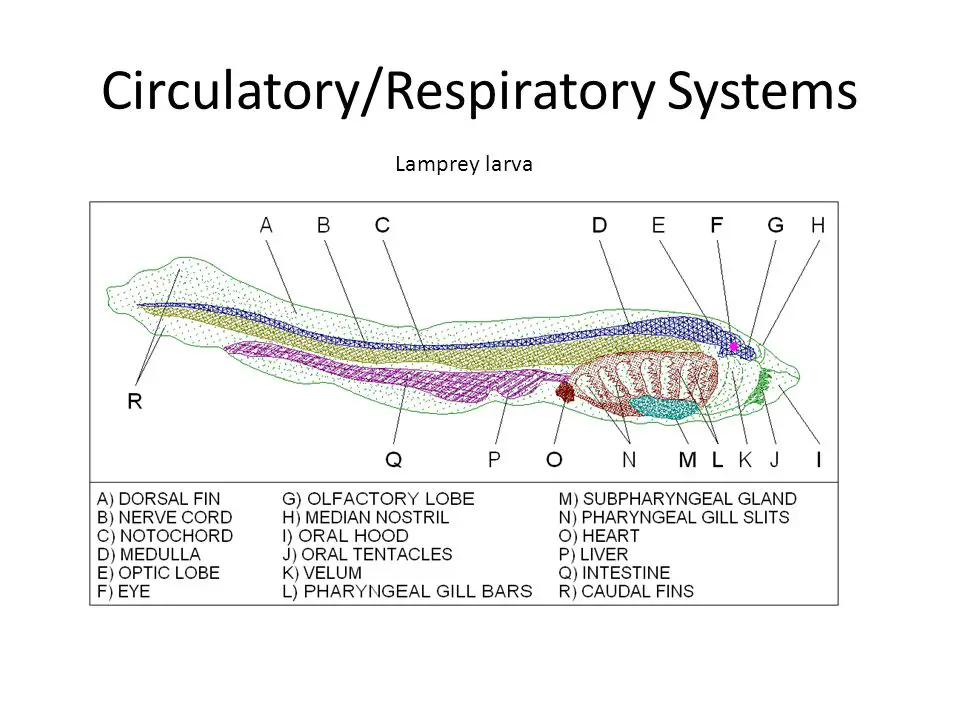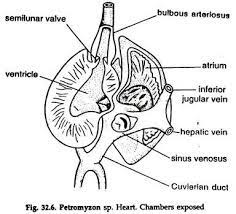Respiratory System of Petromyzon:
On the lateral side of the head, seven pairs of gill slits are present, the gills are present inside the gill pouches. Between the respiratory pharynx and the body wall the gill pouches present, on external appearance, each gill pouch looks like a biconvex lens. The gill pouches are separate from each other by the inter-branchial septa, the gill pouches have several folds internally, the fold is known as gill lamellae.
The outer wall of gill pouches is highly muscular and vascularized with the fine network of blood capillaries, the gaseous exchange occurs inside the gill pouches. Each gill pouches open outside through the external gill slits and the respiratory pharynx connected to each gill pouches through internal gill slits.
Respiratory Mechanism in Petromyzon:
The dissolved gases are the main source of respiratory gases in Petromyzon, the water current enters into their mouth give supply for respiratory gases. In the larval stage, the water current enters through the mouth and exit outside through the gill slits but in adult Petromyzon, the water current goes inside the respiratory pharynx as well as enter into the gill pouches.
In larval Petromyzon, the water can enter through the mouth continuously so the respiratory gases exchange occurs continuously but in the adult stage, the Petromyzon when attached to the other host fishes their mouth does not remain open for taking water current inside the mouth. In an adult, a portion of water current remains inside the blind sac respiratory pharynx tube, when the Petromyzon feeds on other fishes the dissolved respiratory gases in the respiratory pharynx are used for respiration.

The digestive tract and respiratory pharynx open together in the buccal cavity, the water in the respiratory pharynx does not enter into the digestive system due to the presence of velum.
Circulatory System of Petromyzon:
The main element of the circulatory system, the heart present ventrally inside the covering of the pericardium, the heart is protected by a cartilaginous endoskeleton. The ‘S-shaped heart is present near the last pair of gill pouch, the heart in the larval stage is a straight tube-like structure but in the adult stage due to accommodate in small space the heart twist and become an ‘S’ shape.

The heart of Petromyzon has a four-chamber, one auricle, one ventricle, one conus arteriosus, and sinus venosus. The carbon dioxide-rich blood from different parts of the body reaches the sinus venosus, from sinus venosus the blood enters the auricle. Then the blood goes from the auricle to the ventricle, the wall of the ventricle is much thicker than the auricle, the wall of the ventricle contracts, and the blood pump into the ventral aorta.
The ventral aorta then sends the deoxygenated blood into seven pairs of afferent branchial arteries which give supply to the gill pouches. The deoxygenated blood becomes oxygenated in gill pouches and then the efferent branchial arteries come outside of the gill pouches and jointly open into a median dorsal aorta, the median dorsal aorta supplies blood to other parts of the body.
The blood has red blood corpuscles and white blood corpuscles, the hepatic portal system present, renal portal system remain absent lymphatic system present. The white blood corpuscles are of different shapes and sizes, the red blood corpuscles are circular and nucleated, the tissues present inside the spiral valve, kidney, spinal cord take part in blood cell formation.
The median dorsal aorta gives several segmental arteries in their path, the segmental arteries give supply to the myotomes. Some cells (chromaffin cells) in segmental arteries and veins secret adrenaline-like secretion.

The arterial system of Petromyzon have a valve at their origin which helps to reduce the blood pressure on the arteries, but the efferent branchial arteries and renal arteries do not have such a valve to reduce the blood pressure on those arteries.
Detailed Study On
Digestive System and Feeding Mechanism of Petromyzon
Anatomy of Petromyzon (Lamprey)
External Morphology of Petromyzon
Habit and Habitat of Petromyzon(Lamprey)
Classification of Class Ostracodermi
Phylogeny of Subphylum Vertebrata
An Overview of Classification in Subphylum Vertebrata
Subphylum Vertebrata and its Diversity
Cephalochordata Characteristics Features Classification Examples and Diagram
Urochordata Classification Morphology Characteristic Features
Characteristics Features of Hemichordata
General Comparison of Hemichordata Urochordata and Cephalochordata
Comparative Study of Digestive System in Hemichordata Cephaochordata and Urochordata
Hi Everyone!!! Welcome to Imaluop. Imaluop always try to learn some new and he want to share to other people. Here we will try to learn various topics on Science, specially on Biological Sciences.